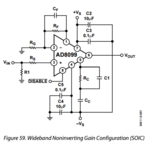KD494
Member level 5
- Joined
- Jun 24, 2015
- Messages
- 83
- Helped
- 13
- Reputation
- 26
- Reaction score
- 13
- Trophy points
- 1,288
- Location
- Boston, MA
- Activity points
- 2,058
Hi all,
I'm working on a high speed circuit using the AD8099 Op Amp. I'm looking at the applications diagram and I see some resistors that I just plain don't understand. (See image below)

I'm referring to Rs and R1, the explanation given by the datasheet is posted below.
I've had problems in the past understanding the concept of termination and this is really throwing me off. Now for what I do know:
-I understand that in the high frequency range you need to match the impedance of a source in order to minimize reflections.
-If my source has a 50 ohm output resistance I can make R1 50 ohms, matching the impedance but losing half my voltage level.
The only thing I don't understand about this resistor is when it is needed and when you can ignore the effect of the transmission line? All the time I see circuits without this terminating resistor and they seem to work just fine, is there a rule of thumb? What if my circuit was differential, do I need to terminate both inputs?
As for Rs I just really don't see its purpose. It will be in series with the already high input impedance of the Op Amp and not make much a difference. Its in the same place as an input bias current cancellation resistor, is that the point. The explanation given on the data sheet just doesnt mean anything to me.
Is anyone out there able to explain this a little better to me or refer me to a source, everything I find online seems to assume I know a little more about this stuff than I do.
Thanks in advance!
I'm working on a high speed circuit using the AD8099 Op Amp. I'm looking at the applications diagram and I see some resistors that I just plain don't understand. (See image below)

I'm referring to Rs and R1, the explanation given by the datasheet is posted below.
R1—This resistor terminates the input of the amplifier to the
source resistance of the signal source, typically 50 Ω. (This is
application specific and not always required.)
RS—Many high speed amplifiers in low gain configurations
require that the input stage be terminated into a nominal
impedance to maintain stability. The value of RS should be kept
to 50 Ω or lower to maintain low noise performance. At higher
gains, RS may be reduced or even eliminated. Typical range is
0 Ω to 50 Ω.
I've had problems in the past understanding the concept of termination and this is really throwing me off. Now for what I do know:
-I understand that in the high frequency range you need to match the impedance of a source in order to minimize reflections.
-If my source has a 50 ohm output resistance I can make R1 50 ohms, matching the impedance but losing half my voltage level.
The only thing I don't understand about this resistor is when it is needed and when you can ignore the effect of the transmission line? All the time I see circuits without this terminating resistor and they seem to work just fine, is there a rule of thumb? What if my circuit was differential, do I need to terminate both inputs?
As for Rs I just really don't see its purpose. It will be in series with the already high input impedance of the Op Amp and not make much a difference. Its in the same place as an input bias current cancellation resistor, is that the point. The explanation given on the data sheet just doesnt mean anything to me.
Is anyone out there able to explain this a little better to me or refer me to a source, everything I find online seems to assume I know a little more about this stuff than I do.
Thanks in advance!